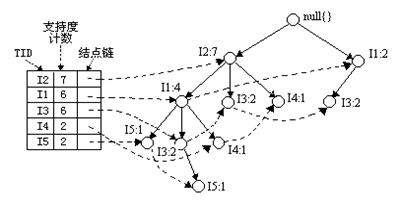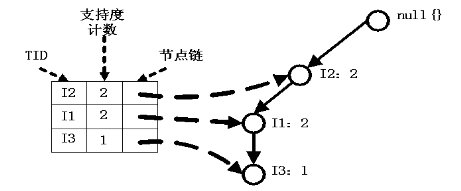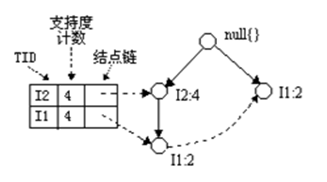FP-Tree频繁模式树算法
来源:互联网 发布:二次元动态桌面软件 编辑:程序博客网 时间:2024/05/16 12:34
参考资料:http://blog.csdn.net/sealyao/article/details/6460578
更多数据挖掘算法:https://github.com/linyiqun/DataMiningAlgorithm
介绍
FP-Tree算法全称是FrequentPattern Tree算法,就是频繁模式树算法,他与Apriori算法一样也是用来挖掘频繁项集的,不过不同的是,FP-Tree算法是Apriori算法的优化处理,他解决了Apriori算法在过程中会产生大量的候选集的问题,而FP-Tree算法则是发现频繁模式而不产生候选集。但是频繁模式挖掘出来后,产生关联规则的步骤还是和Apriori是一样的。
算法原理
FP树,FP树,那他当然是最终被构造成一个树的形状了。所以步骤如下:
1、创建根节点,用NULL标记。
2、统计所有的事务数据,统计事务中各个类型项的总支持度(在下面的例子中就是各个商品ID的总个数)
3、依次读取每条事务,比如T1, 1, 2, 5,因为按照总支持度计数数量降序排列,输入的数据顺序就是2, 1, 5,然后挂到根节点上。
4、依次读取后面的事务,并以同样的方式加入的FP树中,顺着根节点路径添加,并更新节点上的支持度计数。
最后就会形成这样的一棵树:

然后还要新建一个项头表,代表所有节点的类型和支持度计数。这个东西在后面会有大用处。如果你以为FP树的算法过程到这里就结束了,你就大错特错了,算法的终结过程为最后的FP树只包括但路径,就是树呈现直线形式,也就是节点都只有1个孩子或没有孩子,顺着一条线下来,没有其他的分支。这就算是一条挖掘出的频繁模式。所以上面的算法还要继续递归的构造FP树,递归构造FP树的过程:
1、这时我们从最下面的I5开始取出。把I5加入到后缀模式中。后缀模式到时会于频繁模式组合出现构成最终的频繁模式。
2、获取频繁模式基,<I2, Ii>,<I2, I1, I3>,计数为I5节点的count值,然后以这2条件模式基为输入的事务,继续构造一个新的FP树

3、这就是我们要达到的FP树单路径的目标了,不过这里个要求,要把支持度计数不够的点排除,这里的I3:1就不符号,所以最后I5后缀模式下的<I2, I1>与I5的组合模式了,就为<I2, I5>, <I1, I5>,<I1, I2, I5>。
I5下的挖掘频繁模式是比较简单的,没有出现递归,看一下I3下的递归构造,这就不简单了,同样的操作,最后就会出现下面这幅图的样子: 
发现还不是单条路径,继续递归构造,此时的后缀模式硬卧I3+I1,就是<I3, I1>,然后就来到了下面这幅图的情形了。

后面的例子会有更详细的说明。
算法的实现
输入数据如下:
交易ID
商品ID列表
T100
I1,I2,I5
T200
I2,I4
T300
I2,I3
T400
I1,I2,I4
T500
I1,I3
T600
I2,I3
T700
I1,I3
T800
I1,I2,I3,I5
T900
I1,I2,I3
在文件中的形式就是:- T1 1 2 5
- T2 2 4
- T3 2 3
- T4 1 2 4
- T5 1 3
- T6 2 3
- T7 1 3
- T8 1 2 3 5
- T9 1 2 3
- /**
- * FP树节点
- *
- * @author lyq
- *
- */
- public class TreeNode implements Comparable<TreeNode>, Cloneable{
- // 节点类别名称
- private String name;
- // 计数数量
- private Integer count;
- // 父亲节点
- private TreeNode parentNode;
- // 孩子节点,可以为多个
- private ArrayList<TreeNode> childNodes;
- public TreeNode(String name, int count){
- this.name = name;
- this.count = count;
- }
- public String getName() {
- return name;
- }
- public void setName(String name) {
- this.name = name;
- }
- public Integer getCount() {
- return count;
- }
- public void setCount(Integer count) {
- this.count = count;
- }
- public TreeNode getParentNode() {
- return parentNode;
- }
- public void setParentNode(TreeNode parentNode) {
- this.parentNode = parentNode;
- }
- public ArrayList<TreeNode> getChildNodes() {
- return childNodes;
- }
- public void setChildNodes(ArrayList<TreeNode> childNodes) {
- this.childNodes = childNodes;
- }
- @Override
- public int compareTo(TreeNode o) {
- // TODO Auto-generated method stub
- return o.getCount().compareTo(this.getCount());
- }
- @Override
- protected Object clone() throws CloneNotSupportedException {
- // TODO Auto-generated method stub
- //因为对象内部有引用,需要采用深拷贝
- TreeNode node = (TreeNode)super.clone();
- if(this.getParentNode() != null){
- node.setParentNode((TreeNode) this.getParentNode().clone());
- }
- if(this.getChildNodes() != null){
- node.setChildNodes((ArrayList<TreeNode>) this.getChildNodes().clone());
- }
- return node;
- }
- }
- package DataMining_FPTree;
- import java.io.BufferedReader;
- import java.io.File;
- import java.io.FileReader;
- import java.io.IOException;
- import java.util.ArrayList;
- import java.util.Collections;
- import java.util.HashMap;
- import java.util.Map;
- /**
- * FPTree算法工具类
- *
- * @author lyq
- *
- */
- public class FPTreeTool {
- // 输入数据文件位置
- private String filePath;
- // 最小支持度阈值
- private int minSupportCount;
- // 所有事物ID记录
- private ArrayList<String[]> totalGoodsID;
- // 各个ID的统计数目映射表项,计数用于排序使用
- private HashMap<String, Integer> itemCountMap;
- public FPTreeTool(String filePath, int minSupportCount) {
- this.filePath = filePath;
- this.minSupportCount = minSupportCount;
- readDataFile();
- }
- /**
- * 从文件中读取数据
- */
- private void readDataFile() {
- File file = new File(filePath);
- ArrayList<String[]> dataArray = new ArrayList<String[]>();
- try {
- BufferedReader in = new BufferedReader(new FileReader(file));
- String str;
- String[] tempArray;
- while ((str = in.readLine()) != null) {
- tempArray = str.split(" ");
- dataArray.add(tempArray);
- }
- in.close();
- } catch (IOException e) {
- e.getStackTrace();
- }
- String[] temp;
- int count = 0;
- itemCountMap = new HashMap<>();
- totalGoodsID = new ArrayList<>();
- for (String[] a : dataArray) {
- temp = new String[a.length - 1];
- System.arraycopy(a, 1, temp, 0, a.length - 1);
- totalGoodsID.add(temp);
- for (String s : temp) {
- if (!itemCountMap.containsKey(s)) {
- count = 1;
- } else {
- count = ((int) itemCountMap.get(s));
- // 支持度计数加1
- count++;
- }
- // 更新表项
- itemCountMap.put(s, count);
- }
- }
- }
- /**
- * 根据事物记录构造FP树
- */
- private void buildFPTree(ArrayList<String> suffixPattern,
- ArrayList<ArrayList<TreeNode>> transctionList) {
- // 设置一个空根节点
- TreeNode rootNode = new TreeNode(null, 0);
- int count = 0;
- // 节点是否存在
- boolean isExist = false;
- ArrayList<TreeNode> childNodes;
- ArrayList<TreeNode> pathList;
- // 相同类型节点链表,用于构造的新的FP树
- HashMap<String, ArrayList<TreeNode>> linkedNode = new HashMap<>();
- HashMap<String, Integer> countNode = new HashMap<>();
- // 根据事物记录,一步步构建FP树
- for (ArrayList<TreeNode> array : transctionList) {
- TreeNode searchedNode;
- pathList = new ArrayList<>();
- for (TreeNode node : array) {
- pathList.add(node);
- nodeCounted(node, countNode);
- searchedNode = searchNode(rootNode, pathList);
- childNodes = searchedNode.getChildNodes();
- if (childNodes == null) {
- childNodes = new ArrayList<>();
- childNodes.add(node);
- searchedNode.setChildNodes(childNodes);
- node.setParentNode(searchedNode);
- nodeAddToLinkedList(node, linkedNode);
- } else {
- isExist = false;
- for (TreeNode node2 : childNodes) {
- // 如果找到名称相同,则更新支持度计数
- if (node.getName().equals(node2.getName())) {
- count = node2.getCount() + node.getCount();
- node2.setCount(count);
- // 标识已找到节点位置
- isExist = true;
- break;
- }
- }
- if (!isExist) {
- // 如果没有找到,需添加子节点
- childNodes.add(node);
- node.setParentNode(searchedNode);
- nodeAddToLinkedList(node, linkedNode);
- }
- }
- }
- }
- // 如果FP树已经是单条路径,则输出此时的频繁模式
- if (isSinglePath(rootNode)) {
- printFrequentPattern(suffixPattern, rootNode);
- System.out.println("-------");
- } else {
- ArrayList<ArrayList<TreeNode>> tList;
- ArrayList<String> sPattern;
- if (suffixPattern == null) {
- sPattern = new ArrayList<>();
- } else {
- // 进行一个拷贝,避免互相引用的影响
- sPattern = (ArrayList<String>) suffixPattern.clone();
- }
- // 利用节点链表构造新的事务
- for (Map.Entry entry : countNode.entrySet()) {
- // 添加到后缀模式中
- sPattern.add((String) entry.getKey());
- //获取到了条件模式机,作为新的事务
- tList = getTransactionList((String) entry.getKey(), linkedNode);
- System.out.print("[后缀模式]:{");
- for(String s: sPattern){
- System.out.print(s + ", ");
- }
- System.out.print("}, 此时的条件模式基:");
- for(ArrayList<TreeNode> tnList: tList){
- System.out.print("{");
- for(TreeNode n: tnList){
- System.out.print(n.getName() + ", ");
- }
- System.out.print("}, ");
- }
- System.out.println();
- // 递归构造FP树
- buildFPTree(sPattern, tList);
- // 再次移除此项,构造不同的后缀模式,防止对后面造成干扰
- sPattern.remove((String) entry.getKey());
- }
- }
- }
- /**
- * 将节点加入到同类型节点的链表中
- *
- * @param node
- * 待加入节点
- * @param linkedList
- * 链表图
- */
- private void nodeAddToLinkedList(TreeNode node,
- HashMap<String, ArrayList<TreeNode>> linkedList) {
- String name = node.getName();
- ArrayList<TreeNode> list;
- if (linkedList.containsKey(name)) {
- list = linkedList.get(name);
- // 将node添加到此队列中
- list.add(node);
- } else {
- list = new ArrayList<>();
- list.add(node);
- linkedList.put(name, list);
- }
- }
- /**
- * 根据链表构造出新的事务
- *
- * @param name
- * 节点名称
- * @param linkedList
- * 链表
- * @return
- */
- private ArrayList<ArrayList<TreeNode>> getTransactionList(String name,
- HashMap<String, ArrayList<TreeNode>> linkedList) {
- ArrayList<ArrayList<TreeNode>> tList = new ArrayList<>();
- ArrayList<TreeNode> targetNode = linkedList.get(name);
- ArrayList<TreeNode> singleTansaction;
- TreeNode temp;
- for (TreeNode node : targetNode) {
- singleTansaction = new ArrayList<>();
- temp = node;
- while (temp.getParentNode().getName() != null) {
- temp = temp.getParentNode();
- singleTansaction.add(new TreeNode(temp.getName(), 1));
- }
- // 按照支持度计数得反转一下
- Collections.reverse(singleTansaction);
- for (TreeNode node2 : singleTansaction) {
- // 支持度计数调成与模式后缀一样
- node2.setCount(node.getCount());
- }
- if (singleTansaction.size() > 0) {
- tList.add(singleTansaction);
- }
- }
- return tList;
- }
- /**
- * 节点计数
- *
- * @param node
- * 待加入节点
- * @param nodeCount
- * 计数映射图
- */
- private void nodeCounted(TreeNode node, HashMap<String, Integer> nodeCount) {
- int count = 0;
- String name = node.getName();
- if (nodeCount.containsKey(name)) {
- count = nodeCount.get(name);
- count++;
- } else {
- count = 1;
- }
- nodeCount.put(name, count);
- }
- /**
- * 显示决策树
- *
- * @param node
- * 待显示的节点
- * @param blankNum
- * 行空格符,用于显示树型结构
- */
- private void showFPTree(TreeNode node, int blankNum) {
- System.out.println();
- for (int i = 0; i < blankNum; i++) {
- System.out.print("\t");
- }
- System.out.print("--");
- System.out.print("--");
- if (node.getChildNodes() == null) {
- System.out.print("[");
- System.out.print("I" + node.getName() + ":" + node.getCount());
- System.out.print("]");
- } else {
- // 递归显示子节点
- // System.out.print("【" + node.getName() + "】");
- for (TreeNode childNode : node.getChildNodes()) {
- showFPTree(childNode, 2 * blankNum);
- }
- }
- }
- /**
- * 待插入节点的抵达位置节点,从根节点开始向下寻找待插入节点的位置
- *
- * @param root
- * @param list
- * @return
- */
- private TreeNode searchNode(TreeNode node, ArrayList<TreeNode> list) {
- ArrayList<TreeNode> pathList = new ArrayList<>();
- TreeNode tempNode = null;
- TreeNode firstNode = list.get(0);
- boolean isExist = false;
- // 重新转一遍,避免出现同一引用
- for (TreeNode node2 : list) {
- pathList.add(node2);
- }
- // 如果没有孩子节点,则直接返回,在此节点下添加子节点
- if (node.getChildNodes() == null) {
- return node;
- }
- for (TreeNode n : node.getChildNodes()) {
- if (n.getName().equals(firstNode.getName()) && list.size() == 1) {
- tempNode = node;
- isExist = true;
- break;
- } else if (n.getName().equals(firstNode.getName())) {
- // 还没有找到最后的位置,继续找
- pathList.remove(firstNode);
- tempNode = searchNode(n, pathList);
- return tempNode;
- }
- }
- // 如果没有找到,则新添加到孩子节点中
- if (!isExist) {
- tempNode = node;
- }
- return tempNode;
- }
- /**
- * 判断目前构造的FP树是否是单条路径的
- *
- * @param rootNode
- * 当前FP树的根节点
- * @return
- */
- private boolean isSinglePath(TreeNode rootNode) {
- // 默认是单条路径
- boolean isSinglePath = true;
- ArrayList<TreeNode> childList;
- TreeNode node;
- node = rootNode;
- while (node.getChildNodes() != null) {
- childList = node.getChildNodes();
- if (childList.size() == 1) {
- node = childList.get(0);
- } else {
- isSinglePath = false;
- break;
- }
- }
- return isSinglePath;
- }
- /**
- * 开始构建FP树
- */
- public void startBuildingTree() {
- ArrayList<TreeNode> singleTransaction;
- ArrayList<ArrayList<TreeNode>> transactionList = new ArrayList<>();
- TreeNode tempNode;
- int count = 0;
- for (String[] idArray : totalGoodsID) {
- singleTransaction = new ArrayList<>();
- for (String id : idArray) {
- count = itemCountMap.get(id);
- tempNode = new TreeNode(id, count);
- singleTransaction.add(tempNode);
- }
- // 根据支持度数的多少进行排序
- Collections.sort(singleTransaction);
- for (TreeNode node : singleTransaction) {
- // 支持度计数重新归为1
- node.setCount(1);
- }
- transactionList.add(singleTransaction);
- }
- buildFPTree(null, transactionList);
- }
- /**
- * 输出此单条路径下的频繁模式
- *
- * @param suffixPattern
- * 后缀模式
- * @param rootNode
- * 单条路径FP树根节点
- */
- private void printFrequentPattern(ArrayList<String> suffixPattern,
- TreeNode rootNode) {
- ArrayList<String> idArray = new ArrayList<>();
- TreeNode temp;
- temp = rootNode;
- // 用于输出组合模式
- int length = 0;
- int num = 0;
- int[] binaryArray;
- while (temp.getChildNodes() != null) {
- temp = temp.getChildNodes().get(0);
- // 筛选支持度系数大于最小阈值的值
- if (temp.getCount() >= minSupportCount) {
- idArray.add(temp.getName());
- }
- }
- length = idArray.size();
- num = (int) Math.pow(2, length);
- for (int i = 0; i < num; i++) {
- binaryArray = new int[length];
- numToBinaryArray(binaryArray, i);
- // 如果后缀模式只有1个,不能输出自身
- if (suffixPattern.size() == 1 && i == 0) {
- continue;
- }
- System.out.print("频繁模式:{【后缀模式:");
- // 先输出固有的后缀模式
- if (suffixPattern.size() > 1
- || (suffixPattern.size() == 1 && idArray.size() > 0)) {
- for (String s : suffixPattern) {
- System.out.print(s + ", ");
- }
- }
- System.out.print("】");
- // 输出路径上的组合模式
- for (int j = 0; j < length; j++) {
- if (binaryArray[j] == 1) {
- System.out.print(idArray.get(j) + ", ");
- }
- }
- System.out.println("}");
- }
- }
- /**
- * 数字转为二进制形式
- *
- * @param binaryArray
- * 转化后的二进制数组形式
- * @param num
- * 待转化数字
- */
- private void numToBinaryArray(int[] binaryArray, int num) {
- int index = 0;
- while (num != 0) {
- binaryArray[index] = num % 2;
- index++;
- num /= 2;
- }
- }
- }
- /**
- * FPTree频繁模式树算法
- * @author lyq
- *
- */
- public class Client {
- public static void main(String[] args){
- String filePath = "C:\\Users\\lyq\\Desktop\\icon\\testInput.txt";
- //最小支持度阈值
- int minSupportCount = 2;
- FPTreeTool tool = new FPTreeTool(filePath, minSupportCount);
- tool.startBuildingTree();
- }
- }
- [后缀模式]:{3, }, 此时的条件模式基:{2, }, {1, }, {2, 1, },
- [后缀模式]:{3, 2, }, 此时的条件模式基:
- 频繁模式:{【后缀模式:3, 2, 】}
- -------
- [后缀模式]:{3, 1, }, 此时的条件模式基:{2, },
- 频繁模式:{【后缀模式:3, 1, 】}
- 频繁模式:{【后缀模式:3, 1, 】2, }
- -------
- [后缀模式]:{2, }, 此时的条件模式基:
- -------
- [后缀模式]:{1, }, 此时的条件模式基:{2, },
- 频繁模式:{【后缀模式:1, 】2, }
- -------
- [后缀模式]:{5, }, 此时的条件模式基:{2, 1, }, {2, 1, 3, },
- 频繁模式:{【后缀模式:5, 】2, }
- 频繁模式:{【后缀模式:5, 】1, }
- 频繁模式:{【后缀模式:5, 】2, 1, }
- -------
- [后缀模式]:{4, }, 此时的条件模式基:{2, }, {2, 1, },
- 频繁模式:{【后缀模式:4, 】2, }
- -------
算法编码时的难点
1、在构造树的时候要重新构建一棵树的时候,要不能对原来的树做更改,在此期间用了老的树的对象,又造成了重复引用的问题了,于是果断又new了一个TreeNode,只把原树的name,和count值拿了过来,父子节点关系完全重新构造。
2、在事务生产树的过程中,把事务映射到TreeNode数组中,然后过程就是加Node节点或者更新Node节点的count值,过程简单许多,也许会让人很难理解,应该个人感觉这样比较方便,如果是死板的String[]字符串数组的形式,中间还要与TreeNode各种转化非常麻烦。
3、在计算条件模式基的时候,我是存在了HashMap<String, ArrayList<TreeNode>>map中,并并没有搞成链表的形式,直接在生成树的时候就全部统计好。
4、此处算法用了2处递归,一个地方是在添加树节点的时候,搜索要在哪个node上做添加的方法,searchNode(TreeNode node, ArrayList<TreeNode> list),还有一个是整个的buildFPTree()算法,都不是能够一眼就能看明白的地方。希望大家能够理解我的用意。
FP-Tree算法的缺点
尽管FP-Tree算法在挖掘频繁模式的过程中相较Apriori算法里没有产生候选集了,比Apriori也快了一个数量级上了,但是整体上FP-Tree算法的时间,空间消耗开销上还是挺大的。
- FP-Tree频繁模式树算法
- FP-Tree频繁模式树算法
- 关联规则( Association Rules)之频繁模式树(FP-Tree)
- 频繁模式算法之FP-Growth算法
- 数据挖掘 fp-growth 算法 频繁模式挖掘
- FP-growth算法(一)——通过构建FP树发现频繁项集
- FP-growth算法(一)——通过构建FP树发现频繁项集
- FP-growth算法发现频繁项集(一)——构建FP树
- Fp-tree 算法
- FP-Tree算法
- FP-Tree算法
- FP-Growth序列频繁模式挖掘
- FP-growth算法挖掘频繁项集
- 发现频繁项集FP-growth算法
- FP-Tree算法的实现
- FP-Tree算法的实现
- FP-Tree算法的实现
- FP-Tree算法的实现
- cell上按钮的点击事件
- Fragment与Activity之间的数据交互
- 【转】TCP Socket服务器编程,粘包
- 欢迎使用CSDN-markdown编辑器
- Android初级教程人品计算器
- FP-Tree频繁模式树算法
- ProtoBuf
- JSTL日期比较
- 数据挖掘算法之-关联规则挖掘(Association Rule)
- numba版 自适应差分进化算法 速度超快 可以求解约束问题
- Android学习
- Eclipse中SVN的安装步骤(两种)和使用方法
- java核心机制之JVM
- jQuery.extend() 函数详解


